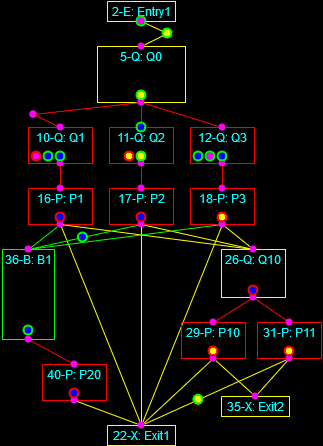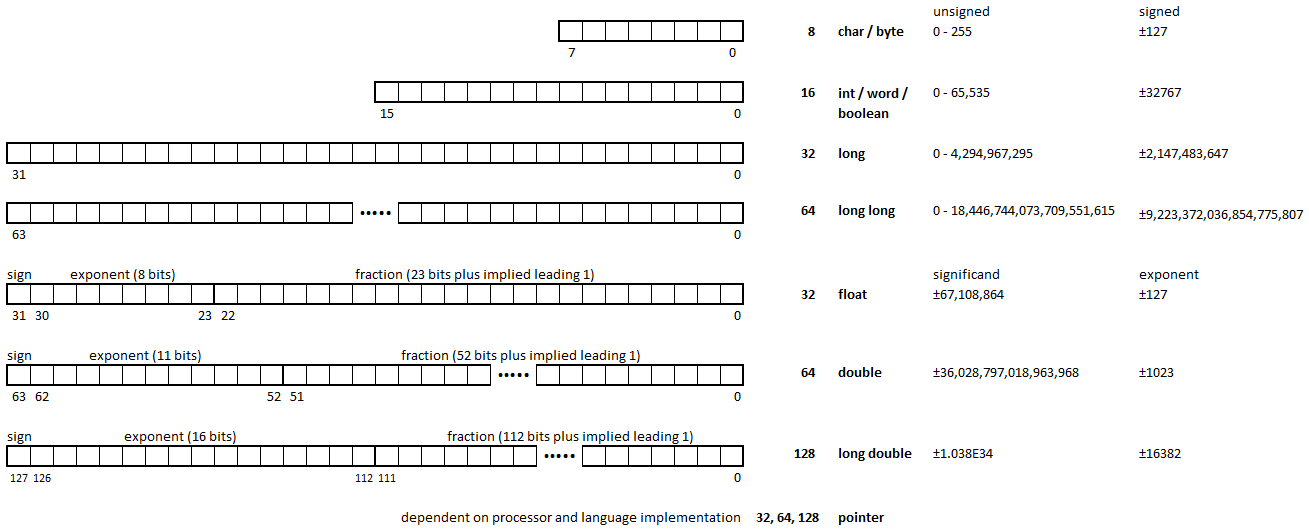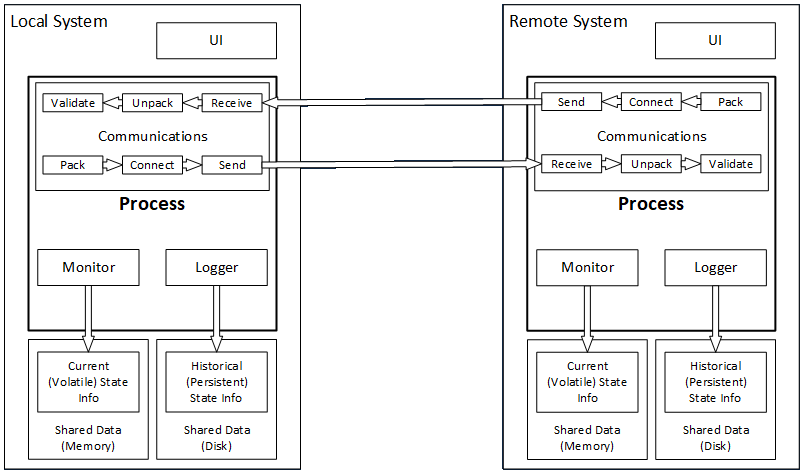A Simulationist's Framework
for Business Analysis
Part 06:
What Business Analysts
Should Know About Software
R.P. Churchill
CBAP, IIBA-CBDA, PMP, CSPO, CSMLean Six Sigma Black Belt
www.rpchurchill.com/presentations/BAseries/06_Software www.rpchurchill.com | Portfolio | Presentations
30 Years of Simulation

Continuous simulation of the heating of a square billet and Discrete-Event simulation of a multi-phase process.
30 Years of Simulation
|
Industries
|
|
|
Computers Store Information As Ones and Zeros

These are examples from C/C++. Other numeric types are possible (e.g., 80-bit floats).
Basic types can be combined into strings, arrays, structures, records, objects, and so on (sometimes requiring you to know where the gaps are).
Computers Can Only Do Six Things
Computing Operations
- Move data from one place to another (Input / Output, Mem <-> CPU) (Interrupt may start new instruction stream.)
- Add two numbers (includes subtraction)
- Bit-twiddle (Shift, Mask, Invert, Logical ops, Status flags)
Instruction Operations (meta-operations)
- Execute next instruction (Automatic after most instructions)
- Jump to different instruction (goto, subroutine)
- Terminate execution
Computers Operate at Multiple Levels (Usually)
BIOS level: Machine level instructions that know how to access some hardware and bootstrap the OS.
Operating System (OS) level: Manages processes, provides background services, facilitates access to all hardware
Application level: Does what the users want. Business Analysts are mostly concerned with applications that serve users.
Cluster level: Systems of multiple computers that perform different functions or replicate functions for scalability, operating as a unified whole.
Programming Tools Exist To Make Things Easier
Translate human-readable code into machine code.
Automate writing code.
Reduce coding errors.
Integrate reference material.
Integrate debugging and test operations.
Manage large projects.
Enhance and organize collaboration.
Manage complexity.
There Are Only A Few Main Language Constructs
- I/O (user input, media output, file read/write, sensor read, controller write)
- Math operations (including logical operators and assignment)
- String operations
- Create / Delete
- If-Then-Else conditionals (including case / switch)
- Counting loop
- Test-at-the-top loop
- Test-at-the-bottom loop
- Jump / Goto
- Subroutines
Bundling data items together into arrays, records, and objects is not a language construct per se, but languages can handle these differently.
In the end the libraries and application frameworks are the bulk of what needs to be learned.
Types of Languages
- Construction language all forms of communication by which a human can specify an executable problem solution to a computer
- Command language, a language used to control the tasks of the computer itself, such as starting other programs
- Configuration language, a language used to write configuration files
- Programming language, a formal language designed to communicate instructions to a machine, particularly a computer
- Markup language, a grammar for annotating a document in a way that is syntactically distinguishable from the text, such as HTML
- Modeling language, a formal language used to express information or knowledge, often for use in computer system design
- Hardware description language, used to model integrated circuits
- Page description language, describes the appearance of a printed page in a higher level than an actual output bitmap
- Query language, a language used to make queries in databases and information systems
- Simulation language, a language used to describe simulations
- Specification language, a language used to describe what a system should do
- Style sheet language, a computer language that expresses the presentation of structured documents, such as CSS
- Transformation language, designed to transform some input text in a certain formal language into a modified output text that meets some specific goal
Generations of Languages
- First-generation (1940s): hand-written machine code in 1s and 0s
- Second-generation (1940s): assembly language, more human readable
- Third-generation (early 1950s): first high-level languages (FORTRAN, COBOL, C/C++, Lisp, Pascal, Java, Javascript)
- Fourth-generation (early 1970s): languages designed for specific purposes (SQL, R, LabView, MATLAB, Appian)
- Fifth-generation (early 1980s): higher level of automation where the problem is defined but the solution was supposed to be figured out automatically. This never happened, which is why we still need BAs.
Most work gets done in third-generation languages.
Languages may fit into or incorporate many different paradigms.
It's All About Trade-offs
Question:
Is it more important to optimize software on speed or memory?
Answer:
It depends.
It's All About Trade-offs (continued)
With power comes responsibility! Newer tools take more work out of the hands of programmers.
Benefits
- Greatly reduced errors
- Improved productivity
- Improved collaboration
- Enhanced ability to manage complexity
Costs
- Increased use of memory and computing power, sometimes by a lot
- Loss of fine control by programmers
- Many programmers have no idea what's going on "under the hood"
Examples
- Automated memory management (garbage collection): Uses memory way less efficiently and can't control when the work is done.
- Simplified data types: Uses memory less efficiently in exchange for simplicity.
- Interpreted vs. compiled: Interpreted languages have to do a lot of work at runtime that can be done up front by a compiler.
- Reduced low-level control: Can't make data items overlap in unions.
- Detailed discussion
It's All About Trade-offs (continued)
List of considerations
|
Computing
|
People and Methods
|
Cost
|
The ultimate optimization is to minimize the total cost of ownership over the entire life cycle.
Communication Models

There are multiple barriers to clear communication.
These can be mitigated by error-checking mechanisms — and by being clear in the first place.
The end blocks can be improved by review, mutual expertise, patience, and empathy.
The middle blocks can be improved by clearing up the communication medium.
Computers Communicate In A Similar Way

...But You Have To Be Careful
Don't assume communications will just work. Make them robust.
Arrange for queues on failures, and retries until success.
Log everything if appropriate.
Be aware of different data types and formats in different languages and on different machines.
Internet and other communications are often set up to deal with differences in data types, as described previously, and endianness, using XML encoding where everything is written out in text.
Other communications, involving video, audio, images, and specialized document formats, are based on published and (often) widely available standards.
Communication for Business Analysts

Talking to customers is improved by mutual expertise, patience, and empathy.
Talking to users is improved by mutual expertise, patience, and empathy.
Talking to technical teams is improved by mutual expertise, patience, and empathy.
Talking to management is improved by mutual expertise, patience, and empathy.
Talking to external entities is improved by mutual expertise, patience, and empathy.
Documentation, review, feedback, and correction are human forms of queuing and retrying.
Non-Functional Requirements
Non-functional requirements are qualities the solution should have, and may also address working methodologies.
Wikipedia lists close to sixty possible NFRs.
All other participants and stakeholders should willingly — and proactively — drive identification and specification of NFRs, and will doubtless have their individual passions, but never be bashful about asking questions which lead to more conversation and specification.
As a BA, consider it your responsibility to drive a thorough exploration of this topic during an engagement.
User Interface / User eXperience (UI/UX)
If the Conceptual Model and Requirements are defined with sufficient clarity and thoroughness, the UI should practically write itself.
A good UI can be pretty or utilitarian, but it's more important that it:
- Clearly displays information: Users should see and understand all the information they need, especially when it comes to actionable output.
- Enables effective control: Users should be able to perform all necessary actions as efficiently and intuitively as possible.
- Maintains situational awareness: Users should always be aware of what has been done and what needs to be done.
- Prevents errors: A good UI will keep users from making errors.
- Facilitates error recovery and correction: If errors do occur (and some are unavoidable), the UI should handle them, identify them to the user, and provide a way for the user to make corrections.
User Interface / User eXperience (UI/UX) (continued)
I've used systems that had absolutely horrible interfaces where you were never confident about what was going on.
Tax software and job search sites often maintain clear situational awareness.
Individual fields can enforce certain formats, can display allowable ranges of values, and show flags or change color when formatting or values are not acceptable.
BAs should have a solid grounding in UI elements and actions, and tools to create mock-ups, wireframes, and so on.
Question: Should there be more than one way to do things?
- VARK method: Visual, Auditory, Read/write, Kinesthetic
- Menu vs. Ribbon vs. Keyboard shortcut vs. graphical/mouse vs. voice
- Accessibility by the disabled, Section 504 and 508 compliance
Trends
Given our discussion of...
- Levels: BIOS - OS - Application - Cluster
- Programming Tools: translation - scale - collaboration - complexity
- Generations: First - Second - Third - Fourth - ?
- Trade-offs: Automated memory management - simplified data - interpreted
...we see that the trend in software languages, tools, development practices, and management, has been in the direction of increasing abstraction in support of greater productivity and complexity.
There Are No Silver Bullets Or Final Answers


Facts and Fallacies of Software Engineering describes 50 years of incremental advance.
This presentation and other information can be found at my website:
E-mail: bob@rpchurchill.com
LinkedIn: linkedin.com/in/robertpchurchill